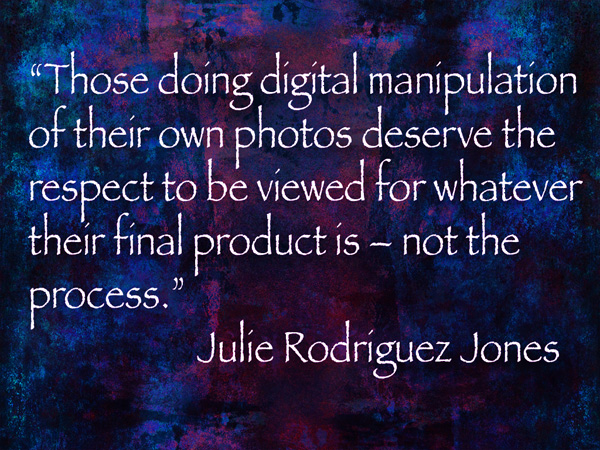“That’s not really photography!”
“You cheat!”
“I never crop I only show what was in the frame originally.”
“I show exactly what was captured by the camera…”
Today’s Photo/Art quote has a lot to do with vision. What does the final image look like? Does it really matter how it arrived in it’s final form? I don’t think so…
 “Those doing digital manipulation of their own photos deserve the respect to be viewed for whatever their final product is – not the process.” – Julie Rodriguez Jones (more quotes from Julie)
“Those doing digital manipulation of their own photos deserve the respect to be viewed for whatever their final product is – not the process.” – Julie Rodriguez Jones (more quotes from Julie)
If you follow my work you know that I am an anything goes kind of guy when creating my artwork. I use multiple layers, textures, blend modes, masks, hue saturation layers and anything else I can think of to get the vision in my head out into the world.
When working on my commercial images I have no problem creating different exposures of the same scene and blending them together with masks to give a better rendition, closer to what the eye will see in that scene, than any one single exposure might.
To those who believe that any photography is “pure photography” I wish for you to think hard about it. All thoughtful photography is art and is very subjective to the maker even if there is no ‘visible’ manipulation.
Many things factor into a photographic image. Lens choice. Choosing what to leave in – or out – of the frame at time of capture. Exposure. ISO. Format choice. Time of day. Add light? Block light? Focus. Depth of field. Black & white, sepia tone or color? High angle or low? When prepping to print – Retouching. Dodging and burning. Choice of medium to print on. The artistic choices are endless…
I don’t feel that someone who has taken an image further via digital methods should be penalized for their choice of tools. Now do some digital images not appeal to you? Maybe not. Or ‘straight’ prints not appeal to you? OK, fine… Please don’t judge how an image was created. Judge the effect the final image has on you regardless of the creation methods.
Ansel Adams is often put forth as one of the great ‘straight’ photographers. But an in-depth study of his work and understanding of how Adams manipulated his medium of film and printing will tell you that his images stand out not because of being straight with his photography but pushing the limits of the tools he had available at the time. He did special exposure and development of his film. He choose the grade of paper on which to print. He spent days manipulating the final image from a negative by dodging and burning a print until it was what he wished it to be.
In 1984 when his autobiography came out he said, “I wish I could be around in 20 years to see what people could get from my negatives via electronic means. It would not be the machine that would be responsible for the final print, but the operator of it. While the images would not necessarily look like mine I believe they would be able to get much more information from the negative than through traditional means.”
Celebrate great imagery no matter how it is created…
Yours in Photography, Bob




